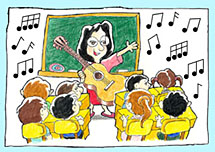Text types: Texts for fun & leisure
| Songs |
Why should we use songs in the English classroom?

|
Songs are an important aspect of English speaking culture, so they do have a
place in the English classroom. Using songs also leads to useful language
learning outcomes as they allow you to focus on rhythm, rhyme and repetition of
grammatical structures and vocabulary. In some ways, songs can be thought of as poems with music.
For more information about poems and ideas for how to use them with
students, click on the menu on the left: Poems & rhymes.
Using songs and music in the classroom has tremendous potential for creating a positive classroom atmosphere. |
How can we use songs in the English classroom?
If you have never introduced songs into your lessons, you might like to start by bringing a cassette recorder or CD player into the classroom and simply playing music softly while students are engaged in writing activities.
Many teachers establish a regular routine of singing songs together. When students are used to the routine of singing songs during English lessons you can introduce simple musical and percussion instruments to accompany the songs. These can include:
| recorders | |
| tambourines | |
| triangles | |
| wooden sticks | |
|
maracas (these are cheap and easily available from music shops.) |
Don't restrict your activities to songs though! You might also like to consider collaborating with the music and PE teachers to see how you can bring English lessons to life with careful use of music and dance.
With a little imagination and planning you should be able to use songs and music as a regular feature of your English lessons.
|
For some practical suggestions about using songs in the classroom, click here: |
 |
There are many good reference books available. Here are some which we particularly recommend:
| Byrne, J. and Waugh, A. (1982) Jingle Bells and Other Songs Oxford University Press | |
| Murphey, T. (1992) Music & Song Oxford English, Oxford University Press | |
| Cranmer, D. and Laroy, C. (1992) Musical Openings: Using music in the language classroom Longman | |
| Hancock, M. (1999) Singing Grammar Cambridge University Press | |
|
English Section, Advisory Inspectorate & Institute of Language in Education. (1994). Poems, Songs and Games for the Primary English Classroom. Hong Kong: Education Department |
|
|
Mok, A. (1997). English Language Enrichment Programme Resource Book. Hong Kong: Faculty of Education, University of Hong Kong. |
There are also some wonderful websites which you should explore. Here are some which we particularly recommend:
| http://www.bbc.co.uk/education/tweenies/songtime/index.shtml (Children's songs from the BBC Tweenies TV series) | |
| http://members.tripod.com/~ESL4Kids/songs.html (Children's songs with suggestions for language focus and teaching) | |
| http://www.kididdles.com/mouseum/index.html (The Musical Mouseum - a collection of favourite children's songs) | |
| http://www.fpx.de/fp/Disney/Lyrics/ (Disney song lyrics) | |
| http://home.nc.rr.com/muppetsongs/ (Collected songs from the Muppets) | |
| http://www.lyrics.com (Collected lyrics of many popular songs) | |
| http://www.geocities.com/EnchantedForest/Glade/8851/index.htm (Becky's campfire songbook) | |
| http://www.pbs.org/rogers/songlist/slindex.htm (Mister Rogers' Songbook - lyrics + audio) | |
| http://www.itschristmas.com/ (Christmas songs) | |
| http://www.montyharper.com (Look through Monty Harper's site for his Online Songbook) | |
| http://www.contemplator.com/folk.html (Folk music of England, Ireland, Scotland, Wales and America) |
Here are some examples of songs which teachers have successfully used in
primary classrooms in Hong Kong.
![]()
If would like to suggest other songs, or share your experiences of using songs, and if you have ideas for activities, please click on the third button below to send a message in to the Teaching Corner.
|
||
To give us feedback about this section, click here or on the Comment button at the top of the screen.
If you have any questions about this section, visit the Language Corner.
If you have any questions or suggestions about how to teach this section, send a message to the Teaching Corner.